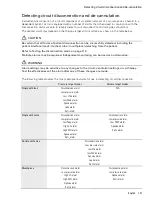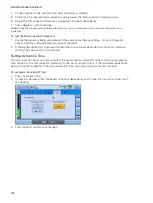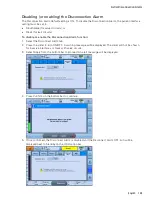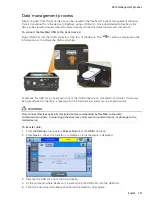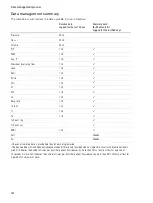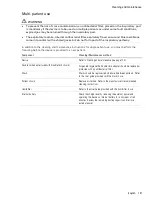
Alarm settings and conditions
116
Obstruction
WARNING
When an obstruction is detected, ventilation is suspended. Ventilation can only resume when the
monitored pressure reduces to below 3 cmH
2
O and the monitored expiratory flow reduces below 1
L/min.
Obstruction may be caused by a circuit obstruction. Obstruction can typically be caused by a pinched
PEEP valve control tube or a blocked exhalation valve outlet.
Note:
The Obstruction alarm will not be triggered if there is an obstruction after the vent, proximal expiratory valve,
or Y piece depending on which circuit is used. To detect such a condition, use the Apnoea, Low Vt and/or Low MV
alarms.
Alarm
Activates when
Obstruction
Using Single Valved and Dual Valved circuits, there is a complete obstruction of the expiratory tube
or exhalation valve or inspiratory tube within 5 seconds or 2 bre
a
ths, whichever is longer.
Using Vented
circuits, there is a complete obstruction of the inspiratory tube (ie, between the
ventilator a
n
d the vent) within 10 seconds.
Using Mouthpiece circuits, there is a complete obstruction of the inspiratory tube within 35 seconds
or 5 breaths, whichever is longer.
Low pressure
Low pressure may be caused by severe leak.
Note:
To allow for mouthpiece ventilation and other exhale to atmosphere configurations, this alarm may be turned
off. For more information, refer to Mouthpiece Settings (see page 101).
Alarm
Activates when
Alarm setting (cmH
2
O)
Low Pressure
Monitored PIP is less than or equal to the Low PIP alarm
setting for two consecutive breaths.
Volume modes
((A)CV, V SIMV)
Off, PEEP+2 to 79 [5]
(Min is 2 when PEEP set to 'Off')
Monitored pressure reaches less than half of the set
pressure support for two consecutive breaths where
measure Ti is greater than or equal to Rise time.
Pressure modes (excluding CPAP)
Off / On [On]
Monitored PIP is less than or equal to set CPAP - 2 cmH
2
O.
CPAP mode
Off / On [On]
PEEP
PEEP alarms activate when the monitored positive expiratory end pressure parameter (PEEP) exceeds
the corresponding alarm setting. When ventilation starts, or after a PEEP setting change, PEEP alarms
are temporarily disabled until:
•
the monitored PEEP is within 2 cm H
2
O of the PEEP setting for three consecutive breaths, or
•
30 seconds has passed.
PEEP alarms may be caused by:
•
circuit disconnection
•
high leak
•
device fault
•
obstruction.
Summary of Contents for Astral 100
Page 1: ...Clinical guide English ...




















